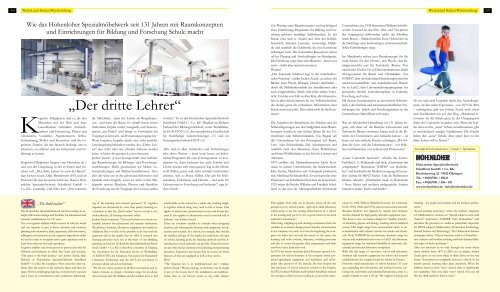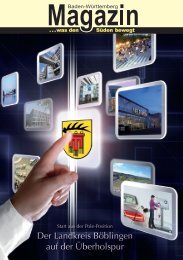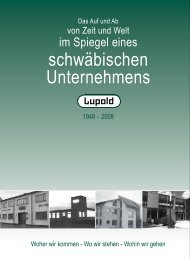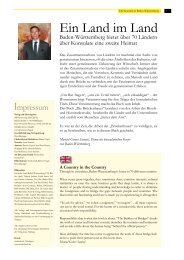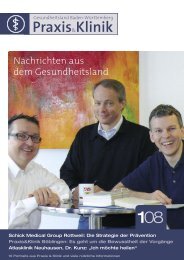WerteLand Baden-Württemberg - PR Presseverlag Süd GmbH
WerteLand Baden-Württemberg - PR Presseverlag Süd GmbH
WerteLand Baden-Württemberg - PR Presseverlag Süd GmbH
Erfolgreiche ePaper selbst erstellen
Machen Sie aus Ihren PDF Publikationen ein blätterbares Flipbook mit unserer einzigartigen Google optimierten e-Paper Software.
208 <strong>WerteLand</strong> <strong>Baden</strong>-<strong>Württemberg</strong><br />
Wie das Hohenloher Spezialmöbelwerk seit 131 Jahren mit Raumkonzepten<br />
und Einrichtungen für Bildung und Forschung Schule macht<br />
Kognitive Fähigkeiten sind es, die den<br />
Menschen mit der Welt und ihrer<br />
Gestaltbarkeit verbinden: Aufmerksamkeit<br />
und Erinnerung, Planen und<br />
Orientieren, Vorstellen, Argumentieren, Selbstbeobachtung,<br />
Wollen und Kreativität sind die kognitiven<br />
Zutaten, die der Mensch benötigt, um zu<br />
erkennen, zu erfahren und aus Erkenntnis und Erfahrung<br />
zu lernen.<br />
Kognitive Fähigkeiten hängen vom Menschen ab –<br />
und von der Umgebung, in der er lernen und forschen<br />
soll. „Der dritte Lehrer ist auch der Raum“,<br />
sagt Jochen Zeuch, Dipl.-Betriebswirt (FH) und als<br />
Prokurist für den Gesamtvertrieb des Hauses Hohenloher<br />
Spezialmöbelwerk Schaffitzel <strong>GmbH</strong> +<br />
Co. KG. zuständig. Und fährt fort: „Erst kommen<br />
„The third teacher“<br />
The Hohenloher Spezialmöbelwerk has been setting an example<br />
with interior design and furniture for educational and<br />
research establishments for 131 years.<br />
It is our cognitive abilities which connect us with the world<br />
and our capacity to give it form: attention and memory,<br />
planning and orientation, ideas, arguments, self-observation,<br />
willingness and creativity are the cognitive ingredients which<br />
we need in order to recognise and to gain experience and to<br />
learn from what we find and experience.<br />
Cognitive abilities vary from person to person and with the<br />
different environments in which they learn and research.<br />
“The space is the third teacher,“ says Jochen Zeuch, Sales<br />
Director at Hohenloher Spezialmöbelwerk Schaffitzel<br />
<strong>GmbH</strong> + Co. KG. He continues: “First come the other students,<br />
then the teacher as the authority figure and then the<br />
space. With its challenging impetus, it creates lively curiosity<br />
and a focus of concentration and contributes understand-<br />
„Der dritte Lehrer“<br />
die Mitschüler, dann der Lehrer als Respektsperson<br />
- und dann der Raum. Er schafft durch seinen<br />
fördernden Impuls wache Neugierde und Konzentration<br />
„am Punkt“ und bringt so Verständnis für<br />
Vorgänge in den Lern- und Forschungsvorgang ein.“<br />
Wenn kognitive Impulse durch eine nicht perfekte<br />
Lernumgebung behindert werden, der „Dritte Lehrer“<br />
also nicht oder nur schwach wirksam werden<br />
kann, so leidet das gesamte Lernen darunter.<br />
Jochen Zeuch: „Unser Kerngeschäft sind nachhaltige<br />
Raumkonzepte für Bildungs- und Forschungseinrichtungen.<br />
Dafür produzieren wir Möbel, Laboreinrichtungen<br />
und Medien-Installationen. Aber<br />
alles das wäre uns in der gebotenen Sichtweise und<br />
Qualität nicht möglich, wenn wir nicht in den Mittelpunkt<br />
unseres Denkens, Planens und Handelns<br />
die Forschung um die Vorgänge des Lernens stellen<br />
ing of the learning and research processes.“ If cognitive<br />
impulses are obstructed by a less than perfect learning environment<br />
so that the „third teacher“ has no or only a very<br />
weak influence, all learning outcomes suffer.<br />
Jochen Zeuch continues: “Our core business is to create sustainable<br />
interiors for educational and research institutions.<br />
We produce furniture, laboratory equipment and media installations.<br />
But it would not be possible to do that with the<br />
approach and in the quality that we offer if research into<br />
learning processes were not at the heart of our thinking,<br />
planning and actions. Hohenloher Spezialmöbelwerk Schaffitzel<br />
<strong>GmbH</strong> + Co. KG is therefore a member of Didacta,<br />
the Association for the Education Sector, of Worlddidac,<br />
of EGNATON, the European Association for Sustainable<br />
Laboratory Technology and the GGT, the association to<br />
promote all-day schools in Germany.<br />
“We are very active partners in all these associations and alliances,<br />
because to design a furniture range for an all-day<br />
school means that the children and the teachers have to feel<br />
würden.“ So ist das Hohenloher Spezialmöbelwerk<br />
Schaffitzel <strong>GmbH</strong> + Co. KG Mitglied im Didacta<br />
Verband der Bildungswirtschaft, in der Worlddidac,<br />
im EGNATON e.V., der europäischen Gesellschaft<br />
für Nachhaltige Labortechnologie e.V. und im<br />
Ganztagsschulverband GGT e.V.<br />
„Wir sind in allen Verbänden und Verbindungen<br />
sehr aktive Partner – denn wenn heute ein Schulmöbel-Programm<br />
für eine Ganztagsschule zu konzipieren<br />
ist, dann bedeutet das auch: Kinder und<br />
Lehrer müssen sich einen ganzen Tag in der Schule<br />
wohl fühlen, gerne und nicht ermüdet miteinander<br />
arbeiten, sich zu Hause fühlen. Das gilt für Klassenräume,<br />
Fachräume und Hörsäle – und auch für<br />
Laboratorien in Forschung und Industrie“, sagt Jochen<br />
Zeuch.<br />
comfortable in the school for a whole day, working happily<br />
together without tiring; they need to feel at home. That<br />
applies to classrooms, special subject rooms and lecture theatres.<br />
It also applies to laboratories used in research and in<br />
industry,“ says Jochen Zeuch.<br />
There are countless variables to consider when designing<br />
interiors, and subsequently furniture and equipment, for education<br />
and research. In a school, for example, they include<br />
the number and age of the pupils, the curriculum, the type<br />
of school, learning goals, the teaching methods and the financing<br />
that a local authority can provide. Financial resources<br />
are often the key element in the planning and purchasing<br />
processes. Experience has shown that six rooms are better<br />
than ten, if they are equipped as well as they can be.<br />
Why?<br />
“The financial key is in multifunctional use,“ explains<br />
Jochen Zeuch. “Physics, biology or chemistry can be taught<br />
in any of the rooms, but if the installations are multifunctional,<br />
then so can history, music or any other subject.<br />
Zur Planung eines Raumkonzeptes und nachfolgend<br />
eines Einrichtungs-Programms für Bildung und Forschung<br />
gehören unzählige Stellschrauben. In der<br />
Schule etwa sind es Anzahl und Alter der Schüler,<br />
Schulstoff, Schulart, Lernziele, notwendige Didaktik<br />
und natürlich die Geldmittel, die eine Kommune<br />
einbringen kann. Die finanziellen Ressourcen stehen<br />
oft bei Planung und Anschaffungen im Mittelpunkt.<br />
Die Erfahrung zeigt: Statt zehn Räumen – besser nur<br />
sechs – dafür aber optimal ausstatten.<br />
Warum?<br />
„Der finanzielle Schlüssel liegt in der multifunktionalen<br />
Nutzung“, erklärt Jochen Zeuch, „in jedem der<br />
Räume kann Physik, Biologie, Chemie stattfinden –<br />
durch die Multifunktionalität der Installationen aber<br />
auch Zeitgeschichte, Musik oder jeder andere Unterricht.<br />
Und das von früh an über Kita, alle Klassenstufen,<br />
in allen Schulsystemen bis zur Volkshochschule,<br />
die abends gerne die vorhandene Infrastruktur einer<br />
Schule nutzt und zahlt. Das rechnet sich für die Kommune.“<br />
Die Aufgaben des Betrachtens, des Sichtens und der<br />
Schlussfolgerungen aus den Stellgrößen eines Raumkonzepts<br />
wurden in sehr frühen Jahren für das Unternehmen<br />
zum Selbstverständnis. Von Beginn sah<br />
das Unternehmen bei der Konzeption auf Raum,<br />
Lern- oder Arbeitsinhalte, Ziel, Arbeitsprozess und<br />
natürlich nach den Menschen, ihren Bedürfnissen<br />
und ihrem Wohlbefinden in der Zeit des Lernens und<br />
Arbeitens.<br />
1879 eröffnet der Mechanikermeister Jakob Kottmann<br />
in seinem Unternehmen, das landwirtschaftliche<br />
Geräte, Maschinen und Velozipeds produziert,<br />
eine Abteilung für Schulmöbel. Er war damit der erste<br />
Produzent von Schulmöbel-Systemen im Kaiserreich.<br />
1923 treten die Brüder Wilhelm und Friedrich Schaffitzel<br />
in das jetzt als Aktiengesellschaft firmierende<br />
That applies from early on, in daycare, across all the year<br />
groups, in every school system – right up to adult education,<br />
which tends to use the existing infrastructure of a school<br />
in the evening and pay for it. It‘s a good return on the local<br />
authority‘s investment.“<br />
Observing, weighing up and drawing conclusions from the<br />
variables in an interior design project became second nature<br />
to the company very early on. From the beginning, the company<br />
has taken into account the nature of the space, the<br />
learning and work content, objectives, working processes<br />
and also of course the people, their requirements and their<br />
comfort as they learn and work.<br />
In 1879, the master mechanic Jakob Kottman opened a department<br />
for school furniture at his company which pro-<br />
duced agricultural equipment and machinery and velocipedes<br />
(the ancestors of the bicycle). He thus became the<br />
first producer of school furniture systems in the Empire.<br />
In 1923, brothers Wilhelm and Friedrich Schaffitzel entered<br />
the company, which was now trading as a joint stock corpo-<br />
Unternehmen ein, 1928 übernimmt Wilhelm Schaffitzel<br />
den Vorstand. In den 50er-, 60er- und 70er-Jahren<br />
des vergangenen Jahrhundert erlebt der Schulbau<br />
einen Boom – Stahlrohrmöbel lösen Holzmöbel ab,<br />
die Nachfrage nach hochwertigen, naturwissenschaftlichen<br />
Einrichtungen steigt.<br />
Im Mittelpunkt stehen jetzt Raumkonzepte für die<br />
vitale Schule, für den Chemie-, den Physik-, den Biologieunterricht<br />
und für Technische Räume. Von<br />
säurefesten Tischen bis zu Dekontaminationen durch<br />
Abzugssysteme für Rauch und Chemikalien. Von<br />
NAWIS ® , dem revolutionären Einrichtungssystem für<br />
naturwissenschaftliche und multifunktionale Räume<br />
bis zu Lab21, dem Laboreinrichtungsprogramm für<br />
grenzenlos flexible Laborarbeitsplätze in Industrie,<br />
Forschung und Lehre.<br />
Mit diesem Gesamtangebot an innovativen Schulmöbeln,<br />
Labormöbeln und naturwissenschaftlichen Einrichtungen<br />
für Schule und Forschungsstätten ist das<br />
Unternehmen Marktführer in Europa.<br />
Was als Schulmöbel-Herstellung vor 131 Jahren begann,<br />
sich dann auf die Bereiche Laboratorien und<br />
Technische Räume erweiterte, hinein auch in die Bereiche<br />
der Universitäten und Industrie-Labore – ist<br />
heute auf eine einfache Formel zu bringen: „Wir fördern<br />
die Lern- und die Lehrsituationen – von Schülern<br />
und Studenten, von Lehrern und Professoren.“<br />
„Guter Unterricht motiviert“, schreibt das Lehrer-<br />
Fachblatt L.A. Multimedia und titelt: „Fachräume mit<br />
„eingebauter“ Motivation: NAWIS ® von Hohenloher“<br />
und beschreibt die Medienversorgung als besonders<br />
wichtig für MINT-Fächer. Und die Heilbronner<br />
Stimme schreibt: „Schulmöbel made in Hohenlohe<br />
– Neue Fächer und moderne pädagogische Ansätze<br />
brauchen andere Tische und Stühle.“<br />
ration. In 1928, Wilhem Schaffitzel became the Chairman.<br />
In the 1950s, 1960s and 1970s, school construction boomed.<br />
Wooden furniture was replaced by tubular steel furniture<br />
and the demand for high-quality scientific equipment rose.<br />
The focus is now on interior design for “healthy schools“,<br />
on chemistry, physics and biology teaching and on technical<br />
rooms. This might range from acid-resistant tables to decontamination<br />
with exhaust systems for smoke and chemicals.<br />
From NAWIS® the revolutionary furniture range for<br />
science and multifunctional rooms to Lab21 the laboratory<br />
equipment range for unlimited flexibility in industrial, educational<br />
and research laboratory workplaces.<br />
With this full range of innovative school and laboratory<br />
furniture and scientific equipment for school and research<br />
establishments, the company leads the market in Europe.<br />
From the initial manufacture of school furniture 131 years<br />
ago, expanding into laboratories and technical rooms, venturing<br />
into universities and industrial laboratories, there is a<br />
simple formula to sum it all up: “We support learning and<br />
<strong>WerteLand</strong> <strong>Baden</strong>-<strong>Württemberg</strong> 209<br />
Als wir nach dem Gespräch durch den Ausstellungsraum<br />
an den vielen Exponaten – von 1879 bis 2010<br />
– vorbeigehen, gibt uns Jochen Zeuch noch etwas<br />
zum Nachdenken mit auf den Weg: „Manchmal renovieren<br />
wir die Schule ganz. In der Übergangszeit<br />
findet der Unterricht woanders statt. Wenn die Kinder<br />
dann in ihre „neue“ Schule zurückkommen, gibt<br />
es entscheidend weniger Vandalismus. Die Kinder<br />
lieben ihre „neue“ Schule. Man spürt: Jetzt ist der<br />
dritte Lehrer voll in Aktion.“<br />
Kontakt & Informationen / Contact + Information<br />
Hohenloher Spezialmöbelwerk<br />
Schaffitzel <strong>GmbH</strong> + Co. KG<br />
Brechdarrweg 22· 74613 Öhringen<br />
Tel.: +49(0)7941 / 696-0<br />
Fax: +49(0)7941 / 696 - 101<br />
www.hohenloher.de· info@hohenloher.de<br />
teaching – for pupils and students and for teachers and lecturers.“<br />
“Good teaching motivates,“ writes the teachers‘ magazine<br />
LA Multimedia in a feature on “Special subject rooms with<br />
“built-in“ motivation: NAWIS® from Hohenloher“ and<br />
describes the provision of media as particularly important<br />
for MINT subjects (Mathematics, Information Technology,<br />
Natural Science and Technology). The Heilbronner Stimme<br />
newspaper writes: “School furniture made in Hohenlohe –<br />
new subjects and modern teaching methods demand different<br />
types of desks and chairs.“<br />
After our interview as we walk through the room where<br />
many exhibits from 1879 to 2010 are on display, Jochen<br />
Zeuch gives us one more thing to think about on the way<br />
home: “Sometimes we completely renovate a school. In the<br />
interim period, teaching takes place elsewhere. When the<br />
children return to their “new“ school, there is significantly<br />
less vandalism. They love their “new“ school. You can tell<br />
that the third teacher is hard at work.“


